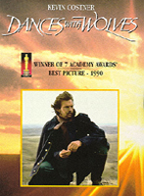 Dances with Wolves probably has the most authentic representation of Native American Indian lifestyle in the movies (along with Black Robe and The Fast Runner). The movie lasting 3 hours can take its time in showing a buffalo hunt, the women working on daily chores, gathering water, the taking down of the tepees.
Dances with Wolves probably has the most authentic representation of Native American Indian lifestyle in the movies (along with Black Robe and The Fast Runner). The movie lasting 3 hours can take its time in showing a buffalo hunt, the women working on daily chores, gathering water, the taking down of the tepees.
It also shows a very positive view of life among the Sioux, particularly in contrast to the white world. The world that Dunbar left was so crazy that he was willing to commit suicide. The commanding officer who gave him his orders did kill himself. Dunbar was really happy to leave "civilization".
The camp he arrived at was a blight on the beautiful natural world.
As Dunbar comes to know the Sioux, he says "Nothing that I had been told about these people has been correct. They are not beggars and thieves. They are not the bogeyman that they are made out to be. on the contrary they are polite guests and have a familiar humor I enjoy." In this revisionist movie Costner is trying to dispel all the myths and stereotypes that had been perpetuated on the Indians and he does a good job.
Looking at the Pawnees from within the closed world of the Sioux we are led to believe that they are evil. When we examine them more objectively we find they are actually presented in a noble fashion much the same way as Magua was in Last of the Mohicans. The warrior played by Wes Studi is actually a brave warrior who attacks the Sioux with just a war club. He is shot in a cowardly manner by the Sioux with their newly acquired rifles.
If we are going to select a villain (besides the US Calvary) I would have to select Dunbar. It was he who equipped the Sioux with rifles, corrupting the way battles had been traditionally been fought between the two tribes. 'Even the old men could not remember such a one sided victory.' With the introduction of firearms the traditional battles between the tribes escalated from largely ceremonial encounters to bloodbaths. Dunbar, like the white settlers that followed, helped destroy the Plains culture.
|